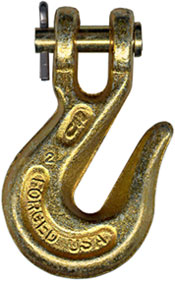
Lifting hooks are frequently used to hoist and raise heavy objects. They are secured to the end of a chain or rope that’s connected to a crane. When the crane rises, so will the lifting hook as well as the object. While all lifting hooks are used to lift heavy objects, though, they are available in several types. Two of the most common types of lifting hooks are grab and slip. What’s the difference between grab hooks and slip hooks?
What Is a Grab Hook?
A grab hook is a type of lifting hook that’s designed to grab the object with which it’s used. Like all lifting hooks, they are designed for overhead lifting applications. Grab hooks are unique because of their open design. As shown in the adjacent photo, they have an open cradle or groove. A chain or rope is attached to the object, after which it’s secured to this open cradle or groove.
What Is a Slip Hook?
A slip hook, on the other hand, is a type of lifting hook that’s characterized by the use of a safety latch. They are still used in overhead lifting applications. Rather than featuring an open design, though, slip hooks featured a closed design. All slip hooks have a safety latch over the cradle or groove.
The safety latch on slip hooks consists of a long and solid metal bar. You can open the safety latch by pressing inward on it. To wrap the end of a chain or rope around a slip hook, for instance, you can simply press the chain or rope against the safety latch. With that said, safety latches only offer one-way action. The safety latch won’t open if the chain or rope presses against it after being installed.
The Difference Between Grab Hooks and Slip Hooks
The main difference between grab hooks and slip hooks is that the former doesn’t have a safety latch, whereas the latter does have a safety latch. There are several different types of grab hooks, some of which include clevis and foundry. Regardless, all grab hooks have an open design without a safety latch. Slip hooks, conversely, have a closed design with a safety latch.
With a safety latch, slip hooks provide greater security for the objects with which they are used. The object won’t come off the slip hook unless there’s an inward force is applied to the safety latch.
